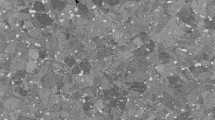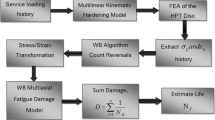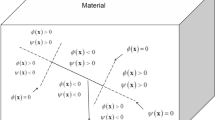Abstract
Aero-engine components have complex geometries and are subjected to various cyclic loads, so they are often in a multi-axial complex stress state during service. It is of great engineering significance to study the multiaxial fatigue properties of nickel-based alloy materials for aero-engines. This paper analyzed the fatigue failure mechanism of nickel-based alloys under biaxial load. The fatigue life can be divided into two parts: fatigue crack initiation life and fatigue crack propagation life. The fatigue crack growth life was predicted by the fatigue crack growth rate model based on the Paris formula. In addition, based on the scaling and superposition theory, the expression of the stress intensity factor K at the crack tip of the cruciform specimen was calculated. In this paper, the first crack that appears in the cross-shaped specimen was used for life prediction.



















Similar content being viewed by others
References
K.S. Li, L.Y. Cheng, Y. Xu, R.Z. Wang, Y. Zhang, X.C. Zhang, S.T. Tu, and H. Miura, A Dual-Scale Modelling Approach for Creep-Fatigue Crack Initiation Life Prediction of Holed Structure in a Nickel-Based Superalloy. Int. J. Fatigue (2022)
Z. Jin. Outline of Structural Integrity of Aero-Engine. Aviation Standardization and Quality, 1990(04):27-29.
Y.M. Xu, S.M. Zhang, T.P. He, X.L. Liu, and X.Y. Chang Prediction of Low-Cycle Crack Initiation Life of Superalloy FGH96 with Inclusion Powder Based on Damage Mechanics. Trans. Nonferrous Met. Soc. China 1–25 (2021)
K.S. Li, R.Z. Wang, G.J. Yuan, S.P. Zhu, X.C. Zhang, S.T. Tu, and H. Miura, A Crystal Plasticity-Based Approach for Creep-Fatigue Life Prediction and Damage Evaluation in a Nickel-Based Superalloy, Int. J. Fatigue, 2021, 143, p 106031.
L. Zhu, X. Hu, R. Jiang, Y. Song, and S. Qu. Experimental Investigation of Small Fatigue Crack Growth Due to Foreign Object Damage in Titanium Alloy TC4. Mater. Sci. Eng. A. (2019)
A.D. Navarro and E.R.D.L. Rios, Short and Long Fatigue Crack Growth: A Unified Model, Philos. Mag. A, 1988, 57(1), p 15–36.
A. Navarro and E.R. Rios, An Alternative Model of the Blocking of Dislocations at Grain Boundaries, Philos. Mag. A, 1988, 57(1), p 37–42.
Z.R. Wu, F.L. Liu, X. Li, L. Fang, Y.D. Song. Multistage Fatigue Modeling of Single-Edge-Notch Tension Specimens for Ni-Based Superalloy GH4169. Adv. Mech. Eng., 2017. https://doi.org/10.1177/1687814017729
L. Zhu, X.T. Hu, R. Jiang, Y.D. Song. An Investigation of Small Fatigue Crack Behavior in Titanium Alloy TC4 Under Different Stress Levels. Proc. Inst. Mech. Eng. G. J. Aerosp. Eng., 2019, 233(15), p 5567–5578.
C.H. Wolf, A. Burgold, S. Henkel, M. Kuna, H. Biermann. Crack Growth Behaviour in Biaxial Stress Fields: Calculation of K-Factors for Cruciform Specimens. Theor. Appl. Fract. Mech., 2020, 107, p 102521.
H.A. Richard, M. Fulland, M. Sander. Theoretical Crack Path Prediction. Fatigue Fract. Eng. Mater. Struct., 2005, 28(1-2), p 3–12.
H.A. Richard, B. Schramm, N.H. Schirmeisen. Cracks on Mixed Mode Loading – Theories, Experiments, Simulations. Int. J. Fatigue, 2014, 62, p 93–103.
A. Sedmak, A. Hemer, S.A. Sedmak, L. Milović, A. Grbović, A. Čabrilo, M. Kljajin. Welded Joint Geometry Effect on Fatigue Crack Growth Resistance in Different Metallic Materials. Int. J. Fatigue, 2021, 150, p 106298.
J. Liang. Research on Fracture and Fatigue Properties of Welded Joints of Superalloy GH4169. 2010.
C. Chen. Fatigue and Fracture. (Wuhan, Huazhong University of Science and Technology Press, 2002).
Elber W. The Significance of Fatigue Crack Closure. Astm Stp, 1971, 486.
Funding
The authors disclosed receipt of the following financial support for research, authorship, and publication of this article: This work was supported by the Fundamental Research Funds for the Central Universities (No. NS2021011). The Major National Science and Technology Project (J2019-IV-0008-0076).
Author information
Authors and Affiliations
Corresponding author
Additional information
Publisher's Note
Springer Nature remains neutral with regard to jurisdictional claims in published maps and institutional affiliations.
Rights and permissions
Springer Nature or its licensor (e.g. a society or other partner) holds exclusive rights to this article under a publishing agreement with the author(s) or other rightsholder(s); author self-archiving of the accepted manuscript version of this article is solely governed by the terms of such publishing agreement and applicable law.
About this article
Cite this article
Wu, Z.R., Mao, Y.S., Lei, H. et al. Fatigue Crack Propagation Life Prediction of GH4169 Under Biaxial Load Based on Cruciform Specimen. J. of Materi Eng and Perform 32, 6365–6379 (2023). https://doi.org/10.1007/s11665-022-07558-x
Received:
Revised:
Accepted:
Published:
Issue Date:
DOI: https://doi.org/10.1007/s11665-022-07558-x




